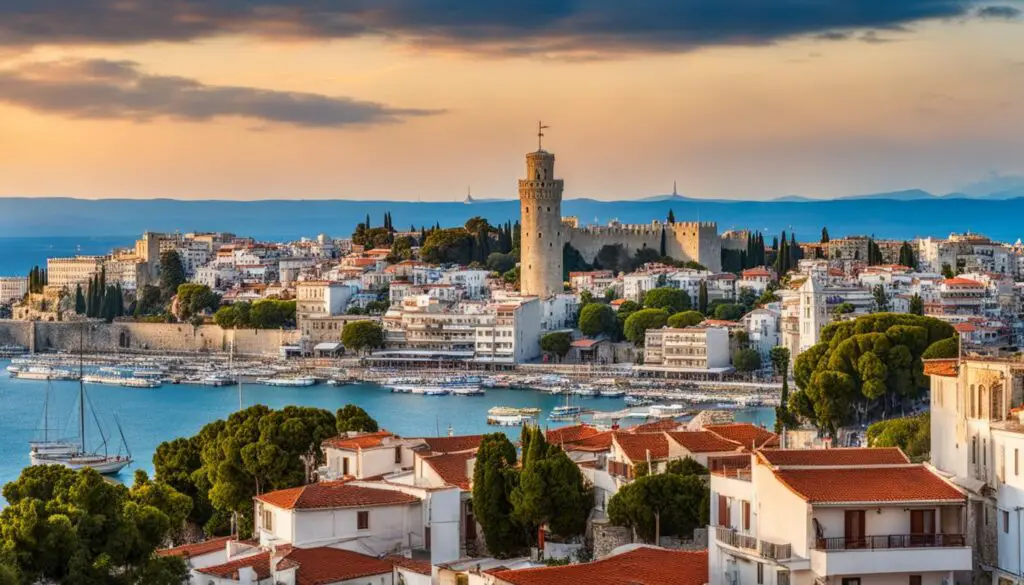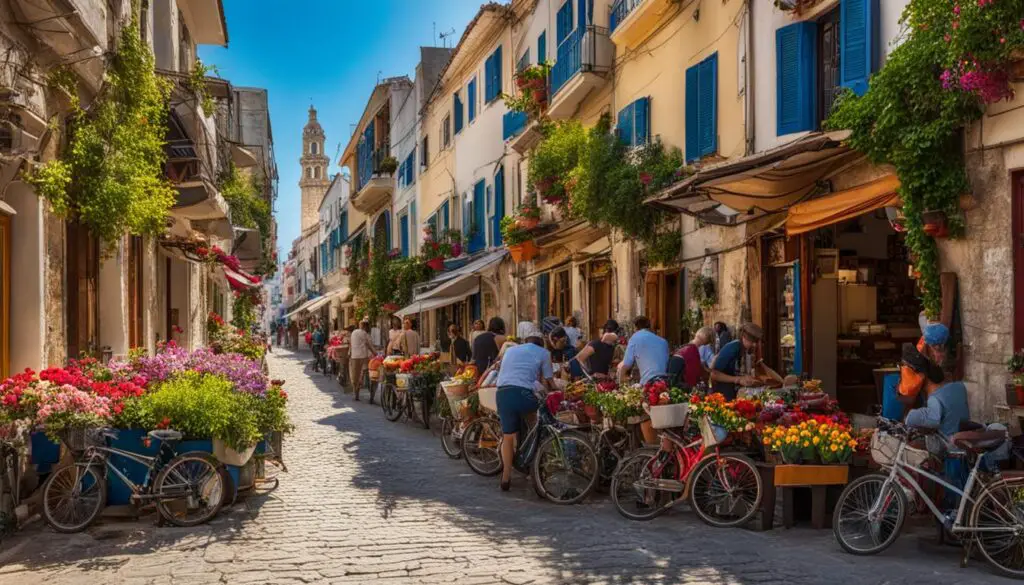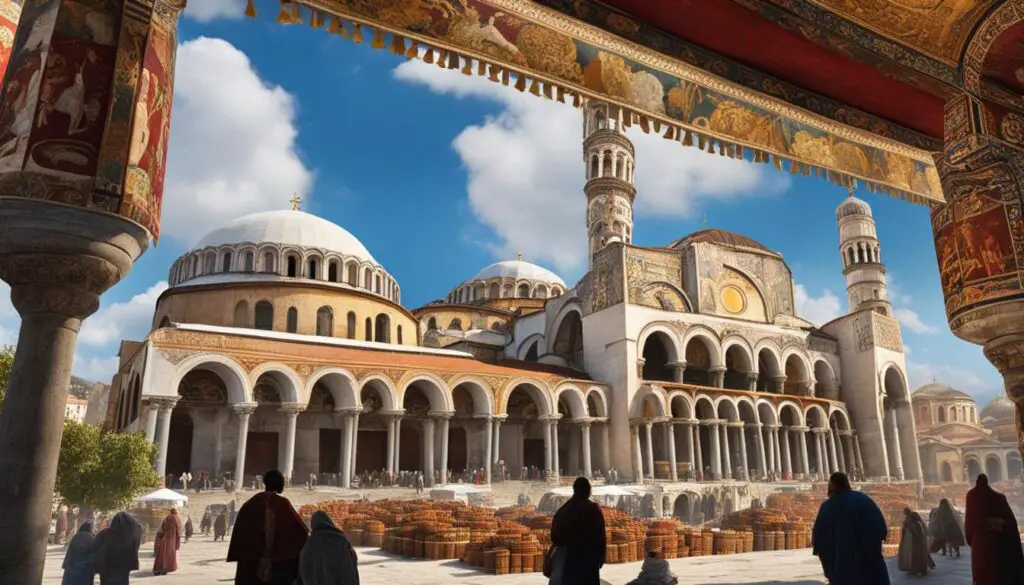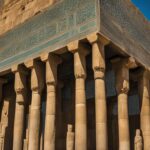Welcome to Thessalonica, also known as Thessaloniki, a captivating city in northern Greece that is steeped in history and boasts a vibrant culture. With its stunning architecture, including the iconic White Tower, Thessalonica is a treasure trove of ancient wonders waiting to be explored.
As one of the most influential cities in the Byzantine Empire, Thessalonica has a rich historical heritage that dates back to ancient times. Notable figures like Aristotle have left their mark on this ancient city, making it a significant destination for history enthusiasts and tourists alike.
In biblical times, Thessalonica held great importance and played a significant role in the spread of Christianity. The Apostle Paul wrote two letters to the Thessalonians, shedding light on the early Christian community and its challenges.
Today, Thessalonica continues to charm visitors with its cultural heritage, archaeological sites, and vibrant atmosphere. From the Museum of Byzantine Culture to the lively waterfront, this city seamlessly blends its historical past with modern developments, offering a unique travel experience.
Key Takeaways:
- Thessalonica is a historical gem in Greece, with a rich cultural heritage.
- Notable biblical figures linked to Thessalonica include the Apostle Paul.
- In biblical times, Thessalonica was a thriving city with diverse cultures and flourishing trade.
- Major biblical events took place in Thessalonica, shaping its religious landscape and history.
- Thessalonica today offers a blend of history, culture, and modern attractions.
The Biblical Importance of Thessalonica
Thessalonica holds significant biblical importance, as it is mentioned in the New Testament of the Bible. The Apostle Paul wrote two letters to the Thessalonians, which are now part of the sacred scriptures. These letters provide insights into the early Christian community in Thessalonica and their struggles. The city played a crucial role in the spread of Christianity in the region, making it a notable biblical site.
Notable biblical figures are linked to Thessalonica, particularly the Apostle Paul and Silas. According to biblical accounts, Paul and Silas traveled to Thessalonica to preach the gospel and establish a Christian community. They faced opposition and persecution from certain factions, but their teachings left a lasting impact on the city’s religious landscape.
Thessalonica in biblical times was a bustling and cosmopolitan city. It was a melting pot of different cultures, attracting Greeks, Romans, Jews, and other groups. The city’s strategic location made it a hub for trade and commerce, contributing to its prosperity. Alongside its vibrant marketplace and diverse population, Thessalonica also had temples dedicated to various gods and impressive architecture.
The Apostle Paul’s Influence
“I give thanks to my God always for you because of the grace of God that was given you in Christ Jesus, that in every way you were enriched in him in all speech and all knowledge— even as the testimony about Christ was confirmed among you— so that you are not lacking in any spiritual gift, as you wait for the revealing of our Lord Jesus Christ, who will sustain you to the end, guiltless in the day of our Lord Jesus Christ.”
| Biblical Events | Impact on Thessalonica |
|---|---|
| The preaching of the Apostle Paul | Establishment of an early Christian community |
| Opposition and persecutions faced by early Christians | Challenges and hardships in spreading their faith |
| Contributions to the spread of Christianity in the region | Influence on the religious landscape of Thessalonica |
Thessalonica in Biblical Times
In biblical times, Thessalonica was a bustling and prosperous city situated in northern Greece. It served as a crucial hub for trade and commerce, attracting people from various cultures and civilizations. The city’s strategic location made it a vital stop on major trade routes connecting Europe and Asia.
Thessalonica was a melting pot of different ethnicities, with a diverse population comprising Greeks, Romans, Jews, and others. Its diverse population contributed to its vibrant marketplace, where goods from different regions were bought and sold. The city also boasted impressive architecture, including temples dedicated to various gods, showcasing the religious practices of its inhabitants.
The city’s thriving ancient cityscape and rich cultural heritage continue to fascinate historians and archeologists. The remnants of ancient Thessalonica provide insights into the daily life, customs, and traditions of its inhabitants during biblical times.
As we explore Thessalonica’s biblical significance further, we will delve into the major biblical events that unfolded in this ancient city and their impact on its history.
The Ancient City of Thessalonica: Key Characteristics
| Characteristics | Details |
|---|---|
| Location | Strategically located on major trade routes connecting Europe and Asia |
| Population | A diverse population comprising Greeks, Romans, Jews, and others |
| Trade and Commerce | A bustling marketplace where goods from different regions were bought and sold |
| Architecture | Impressive temples dedicated to various gods |
| Cultural Heritage | A rich blend of customs, traditions, and practices |
Thessalonica’s biblical importance stems from its historical significance and role in the spread of Christianity. The city’s vibrant ancient cityscape, characterized by trade and commerce, diverse population, and remarkable architecture, set the stage for the biblical events that unfolded within its walls.
Major Biblical Events in Thessalonica
In Thessalonica, several major biblical events took place, leaving a lasting impact on its history. One of the most significant events was the arrival of the Apostle Paul, who preached in the city and established an early Christian community. The teachings of Paul and his companions faced opposition from certain groups, leading to conflicts and persecutions. Despite these challenges, Thessalonica continued to thrive as a center for early Christianity.
An important biblical event in Thessalonica occurred during Paul’s second visit to the city. The Book of Acts mentions that Paul spent three consecutive Sabbaths reasoning with the Jews and proclaiming Christ in the local synagogue. This event played a crucial role in the growth and establishment of the Christian community in Thessalonica.
Another notable biblical event took place during Paul’s time in Thessalonica. The Thessalonian letters, written by the Apostle Paul and included in the New Testament, provide insights into the early Christian community and address various theological and practical matters. These letters are significant not only for their biblical relevance but also for the historical documentation they provide about the early days of the Christian faith in Thessalonica.
“The teachings of Paul and the establishment of the early Christian community in Thessalonica played a critical role in the spread of Christianity in the region and beyond.”
The Impact on History
The major biblical events in Thessalonica had a profound impact on its history. The establishment of an early Christian community laid the foundation for the spread of Christianity throughout the region, contributing to its later significance as a center of religious and cultural importance. The conflicts and persecutions faced by the early Christians in Thessalonica also exemplify the challenges and resilience of the early Christian movement.
Furthermore, the Thessalonian letters written by the Apostle Paul have not only shaped the theological understanding of the Christian faith but also provided historical evidence of the early Christian community and its challenges. These letters serve as a valuable resource for scholars and historians seeking to understand the development of the Christian faith and its impact on ancient societies.
| Biblical Event | Significance |
|---|---|
| Arrival of the Apostle Paul | Establishment of an early Christian community |
| Paul’s preaching in the synagogue | Growth and consolidation of the Christian community |
| The Thessalonian letters | Documentation of early Christian community and theological discussions |
Thessalonica Today
Thessalonica, also known as Thessaloniki, is a city that seamlessly combines its rich historical past with modern developments. Today, it stands as a vibrant and cosmopolitan destination that attracts tourists from all over the world. With its diverse attractions, vibrant culture, and warm hospitality, Thessalonica offers a unique travel experience.

Evidence of Thessalonica’s rich cultural heritage can be found in its numerous museums and archaeological sites.
The city is home to the Museum of Byzantine Culture, where visitors can explore a fascinating collection of artifacts from the Byzantine period. From intricately designed religious icons to stunning mosaics, the museum showcases the artistic and cultural achievements of this era. Thessalonica also boasts the Archaeological Museum, which houses a wide range of ancient artifacts, including sculptures, pottery, and jewelry, providing a glimpse into the city’s rich history.
Thessalonica’s vibrant waterfront and charming neighborhoods offer a unique atmosphere for visitors to explore.
The city’s waterfront promenade is a lively area, lined with cafes, restaurants, and bars, where visitors can enjoy breathtaking views of the Thermaic Gulf. Taking a leisurely stroll along the promenade is a popular activity, especially during the evening when the city lights up. Thessalonica’s neighborhoods, such as Ano Poli and Ladadika, are filled with narrow streets, colorful buildings, and traditional tavernas, creating an enchanting ambiance that showcases the city’s unique character.
Thessalonica’s culinary scene is a testament to its rich culture and history.
The city is renowned for its delicious cuisine, featuring a blend of Greek, Mediterranean, and Balkan flavors. Visitors can indulge in a variety of dishes, from fresh seafood and traditional moussaka to mouthwatering pastries and sweet desserts. Exploring Thessalonica’s food markets, such as Modiano Market, offers an opportunity to discover local produce, spices, and delicacies, providing a true culinary adventure.
| Attractions | Tourism | Culture |
|---|---|---|
| Museum of Byzantine Culture | Waterfront Promenade | Diverse Culinary Scene |
| Archaeological Museum | Vibrant Neighborhoods | Historical Heritage |
| White Tower | Local Markets | Artistic Achievements |
Best Time to Visit Thessalonica
When planning a trip to Thessalonica, it’s essential to choose the best time to visit to make the most of your experience. The city’s climate and seasonal attractions play a significant role in determining the ideal time for your visit.
Spring: Blooming Beauty
Spring, from March to May, is considered one of the best times to visit Thessalonica. The city comes alive with blooming flowers, creating a picturesque and charming atmosphere. The weather is mild, with average temperatures ranging from 12°C (54°F) to 19°C (66°F). The Golden Light Festival, which takes place in April, adds to the vibrant energy of the city, showcasing local art, music, and performances.
Autumn: Mild Temperatures and Colorful Foliage
Autumn, from September to November, is another ideal time to visit Thessalonica. The temperatures are pleasant, ranging from 15°C (59°F) to 23°C (73°F), making it enjoyable for outdoor activities and sightseeing. One of the highlights of autumn in Thessalonica is the colorful foliage, transforming the city into a picturesque autumnal landscape. The International Film Festival, held in November, attracts movie enthusiasts from around the world, adding to the cultural allure of the city.
Summer: Vibrant Atmosphere
While summer, from June to August, is a popular time for tourists to visit Thessalonica, it can be quite hot, with temperatures ranging from 23°C (73°F) to 30°C (86°F). The city’s beaches, such as Peraia and Nea Michaniona, are bustling with visitors seeking sun, sand, and relaxation. However, it’s important to note that summer is also the busiest time, with larger crowds and higher accommodation prices. If you prefer warmer temperatures and enjoy a vibrant atmosphere, summer can still be a great time to experience Thessalonica.
| Season | Temperature Range | Key Events |
|---|---|---|
| Spring | 12°C – 19°C (54°F – 66°F) | Golden Light Festival |
| Autumn | 15°C – 23°C (59°F – 73°F) | International Film Festival |
| Summer | 23°C – 30°C (73°F – 86°F) | Beach Season |
Biblical Significance of Thessalonica: Exploring Its Historical Connections
Thessalonica holds great biblical importance, as it is mentioned in the New Testament and associated with notable biblical figures. The Apostle Paul wrote two letters to the Thessalonians, which are now part of the Bible. These letters provide valuable insights into the early Christian community in Thessalonica and shed light on its significance in the spread of Christianity. Additionally, the city was visited by the Apostle Paul and Silas during their missionary journeys.
In biblical times, Thessalonica was a thriving city with a diverse population. Located in a strategic position on major trade routes, the city was a hub of commerce and cultural exchange. It boasted impressive architecture, vibrant marketplaces, and temples dedicated to various gods. Thessalonica’s historical prominence and role in the biblical narrative make it an intriguing destination for those interested in exploring ancient history and biblical heritage.
Several major biblical events took place in Thessalonica, shaping its history and religious landscape. The Apostle Paul’s preaching and establishment of an early Christian community were met with both support and opposition. Conflicts and persecutions arose as a result, highlighting the significant impact of these events on Thessalonica’s social and religious fabric. Despite the challenges, Thessalonica continued to be a crucial center for early Christianity, contributing to the faith’s expansion throughout the region.
Table: Notable Biblical Figures Linked to Thessalonica
| Biblical Figure | Connection to Thessalonica |
|---|---|
| Apostle Paul | Wrote letters to the Thessalonians and visited the city during his missionary journeys. |
| Silas | Accompanied the Apostle Paul to Thessalonica during their missionary journeys. |
Today, Thessalonica stands as a vibrant city that seamlessly blends its ancient heritage with modern developments. Visitors can explore archaeological sites, such as the Museum of Byzantine Culture, showcasing artifacts from the Byzantine period. The city’s rich history, combined with its lively waterfront, charming neighborhoods, and diverse culinary scene, make it a captivating destination for travelers seeking a unique blend of ancient history, culture, and contemporary energy.
When visiting Thessalonica, the best area to stay is the city center, particularly around Aristotelous Square. This central location provides easy access to major landmarks such as the White Tower, the Archaeological Museum, and the bustling Ladadika district. Whether you prefer luxury hotels or budget-friendly accommodations, the city center offers a diverse range of options to suit different preferences and budgets. Staying in this area allows you to immerse yourself in the vibrant atmosphere of Thessalonica while conveniently exploring its historical and cultural attractions.
Next, we’ll explore the best time to visit Thessalonica, considering both weather conditions and tourist crowds, so you can plan a memorable trip to this historical gem.
How to Travel to Thessalonica
If you’re planning a trip to Thessalonica, it’s important to know the best ways to travel to this captivating city. Thessalonica is well-connected by various transportation options, making it easily accessible for visitors from around the world.
If you’re coming from abroad, the most convenient way to reach Thessalonica is by flying into the Macedonia International Airport (SKG). This airport serves Thessalonica and offers flights from major European cities. Once you arrive at the airport, you can easily reach the city center, which is about 40 minutes away, by taking a bus or taxi.
For those who prefer a scenic journey, there is also a train service from Athens to Thessalonica. The train ride takes approximately 4 hours and provides a comfortable and relaxing travel experience. You can enjoy the picturesque views of the Greek countryside along the way.
Transportation Options to Thessalonica:
| Transportation | Estimated Travel Time |
|---|---|
| Airport Bus | About 40-50 minutes |
| Taxi | Around €20-€25 |
| Train | Approximately 4 hours |
Whether you choose to fly or take the train, traveling to Thessalonica is an exciting journey that sets the stage for an unforgettable experience in this historical gem of Greece.

Thessalonica Airport to City Center Transfer
When arriving at Thessalonica Airport, travelers have several transportation options to reach the city center. Whether you prefer convenience, affordability, or a personalized experience, there is a transfer option that suits your needs.
Express Bus
One of the most convenient and budget-friendly options is to take the express bus number 78. The bus departs from the airport every 30 minutes, and the journey to the city center typically takes about 40 to 50 minutes. This is a popular choice for many travelers as it offers a hassle-free way to reach their destination while enjoying the scenic views along the way.
Taxi
If you prefer a more direct and private transfer, taxis are readily available at the airport. A taxi ride from the airport to the city center usually costs around €20 to €25, depending on the time of day and the season. Taxis offer a convenient and comfortable option for those who want to reach their destination quickly.
Private Transfer
For a personalized and hassle-free transportation experience, private transfer services are also available. These services provide door-to-door transfers, allowing you to relax and enjoy the journey without the worry of navigating public transportation or finding a taxi. Private transfers can be arranged in advance, ensuring a seamless arrival at your accommodation in Thessalonica.
| Transfer Method | Advantages | Disadvantages |
|---|---|---|
| Express Bus | Convenient and affordable | Dependent on bus schedule and may be crowded during peak hours |
| Taxi | Direct and private transfer | More expensive than the bus option |
| Private Transfer | Personalized and hassle-free experience | Usually more expensive than other options |
Whichever transfer option you choose, you’ll soon find yourself in the heart of Thessalonica, ready to explore the city’s historical and cultural gems.
Byzantine Attractions in Greece
Greece is renowned for its rich historical heritage, and one of the most significant periods in its history is the Byzantine Empire. Throughout the country, there are numerous attractions that showcase the splendor and influence of Byzantine art and architecture. These sites provide a glimpse into the empire’s vibrant culture and offer visitors a chance to immerse themselves in Greece’s fascinating past.
Museum of Byzantine Culture, Thessalonica
The Museum of Byzantine Culture, located in Thessalonica, is a must-visit destination for those interested in Byzantine history. The museum’s collection consists of over 3,000 artifacts, including stunning mosaics, religious icons, and intricate jewelry. Visitors can explore the museum’s exhibits, which span from the Early Christian period to the Ottoman Empire, and gain a deeper understanding of the Byzantine Empire’s legacy in Greece.
Kapnikarea Church, Athens
Another remarkable Byzantine attraction is the Kapnikarea church in Athens. This small yet significant church stands as a testament to Byzantine architecture. Built in the 11th century, it features a circular shape and stunning frescoes that depict religious scenes from the Byzantine era. The Kapnikarea church is a hidden gem nestled amidst the bustling streets of Athens, offering a tranquil retreat and a glimpse into the city’s Byzantine past.
Byzantine Museum, Athens
The Byzantine Museum in Athens is a treasure trove of Byzantine artifacts. Its extensive collection includes sculptures, paintings, and decorative arts that span the Byzantine period. With over 25,000 exhibits, the museum provides a comprehensive overview of Byzantine art and culture. Visitors can admire the intricate craftsmanship of Byzantine icons and marvel at the artistic achievements of this influential era in Greek history.
| Attraction | Location |
|---|---|
| Museum of Byzantine Culture | Thessalonica |
| Kapnikarea Church | Athens |
| Byzantine Museum | Athens |
The table above summarizes some of the notable Byzantine attractions in Greece. These sites allow visitors to delve into the rich cultural heritage of the Byzantine Empire and appreciate its enduring influence on Greek art and architecture.

“Byzantine art and architecture have left an indelible mark on Greece’s cultural landscape. These attractions offer a captivating journey through time, allowing visitors to witness the grandeur and artistic prowess of the Byzantine Empire.”
From the grandeur of the Museum of Byzantine Culture in Thessalonica to the quiet beauty of the Kapnikarea church in Athens, Byzantine attractions in Greece provide a unique opportunity to appreciate the empire’s influence. The Benaki Museum in Athens, with its vast collection of Byzantine art, and the iconic White Tower in Thessalonica, which houses a museum dedicated to the city’s history, further enrich the experience. Among the lesser-known gems is the Agios Eleftherios church in Athens, a small yet significant Byzantine structure that showcases the empire’s architectural legacy.
Exploring these attractions allows visitors to immerse themselves in the rich heritage of the Byzantine Empire and gain a deeper understanding of Greece’s cultural identity. The legacy of this influential era continues to shape Greece’s art, architecture, and traditions, making it an integral part of the country’s historical tapestry.
Conclusion
Thessalonica, a historical gem in Greece, is a captivating destination that offers a fascinating blend of history, culture, and architectural beauty. With its biblical importance and rich cultural heritage, Thessalonica is a must-visit city for tourists and history enthusiasts alike.
In biblical times, Thessalonica played a significant role in the spread of Christianity. The Apostle Paul wrote letters to the Thessalonians, which are now part of the Bible, providing insights into the early Christian community in the city. Biblical figures such as the Apostle Paul and Silas were linked to Thessalonica, adding to its historical and cultural significance.
In ancient times, Thessalonica was a thriving city known for its strategic location and diverse population. It served as a trade center and had impressive architecture, vibrant marketplaces, and temples dedicated to various gods. The city’s historical landscape and cultural heritage were shaped by its bustling ancient cityscape.
Thessalonica witnessed major biblical events that had a profound impact on its history. The Apostle Paul preached in the city, establishing one of the earliest Christian communities. Despite facing challenges and persecutions, Thessalonica continued to be a significant center for early Christianity, contributing to the spread of the faith in the region.
Today, Thessalonica remains a vibrant destination that seamlessly combines its historical past with modern developments. Visitors can explore its rich cultural heritage, archaeological sites, and museums that showcase the Byzantine period’s artifacts. The city’s lively waterfront, charming neighborhoods, and diverse dining scene make it a popular choice for tourists seeking a unique blend of history, culture, and contemporary energy.
Discover the wonders of Thessalonica and immerse yourself in the captivating allure of Greece’s cultural capital. Experience the biblical significance, explore the historical attractions, and savor the vibrant culture that makes Thessalonica a truly unmissable destination.
FAQ
What is the historical significance of Thessalonica?
Thessalonica has a rich history dating back to ancient times and has been influenced by various civilizations. It is known for its stunning architecture, including landmarks like the White Tower. Thessalonica is also linked to notable figures such as Aristotle.
What is the biblical importance of Thessalonica?
Thessalonica is mentioned in the New Testament and is associated with the Apostle Paul. He wrote two letters to the Thessalonians, which are now part of the Bible. Thessalonica played a significant role in the spread of Christianity in the region.
What was Thessalonica like in biblical times?
In biblical times, Thessalonica was a prosperous city and an important center for trade and commerce. It had a diverse population and was known for its vibrant marketplace, temples, and impressive architecture. Thessalonica was strategically located on major trade routes connecting Europe and Asia.
What major biblical events took place in Thessalonica?
Thessalonica witnessed the preaching of the Apostle Paul, leading to the establishment of one of the earliest Christian communities. However, Paul’s teachings faced opposition, resulting in conflicts and persecutions. Despite these challenges, Thessalonica remained an important center for early Christianity.
What is Thessalonica like today?
Thessalonica is a vibrant and cosmopolitan city that seamlessly blends its historical past with modern developments. It offers a range of attractions, including archaeological sites, museums, and a lively waterfront. The city’s charm, dining scene, and cultural heritage continue to attract tourists.
When is the best time to visit Thessalonica?
The best times to visit Thessalonica are during spring and autumn. These seasons offer milder temperatures, fewer crowds, and a pleasant atmosphere for exploring the city’s attractions. Spring, in particular, showcases blooming flowers and a warm golden light.
Where is the best area to stay in Thessalonica?
The best area to stay in Thessalonica is the city center, particularly around Aristotelous Square. This central location provides easy access to major landmarks and offers a range of accommodation options to suit different preferences and budgets.
How can I travel to Thessalonica?
Thessalonica is well-connected by various transportation options. The Macedonia International Airport (SKG) serves the city, with flights from major European cities. There is also a train service from Athens to Thessalonica, which offers a comfortable journey with scenic views.
How do I travel from Thessalonica Airport to the city center?
Travelers arriving at Thessalonica Airport can take the express bus number 78, which departs from the airport every 30 minutes. Another option is to take a taxi or use private transfer services for a personalized and hassle-free transportation experience.
What are some Byzantine attractions to visit in Greece?
Greece is home to several remarkable Byzantine attractions. In Thessalonica, the Museum of Byzantine Culture offers a comprehensive exploration of the Byzantine period. In Athens, visitors can admire the Byzantine architecture of the Kapnikarea church and explore the Byzantine Museum. The iconic White Tower in Thessalonica also has a museum dedicated to the city’s history.







